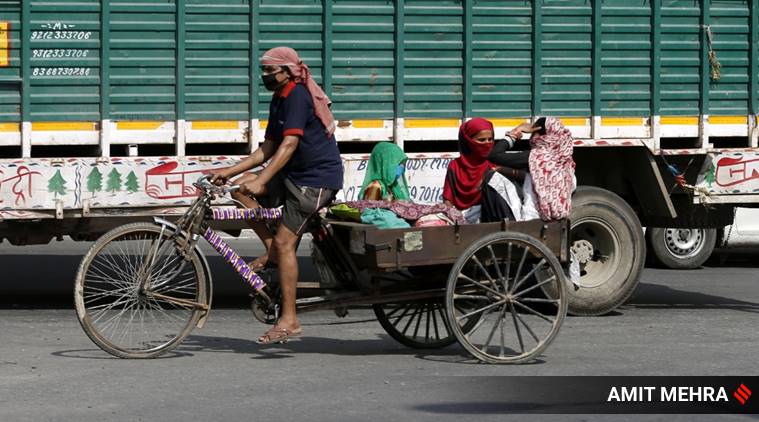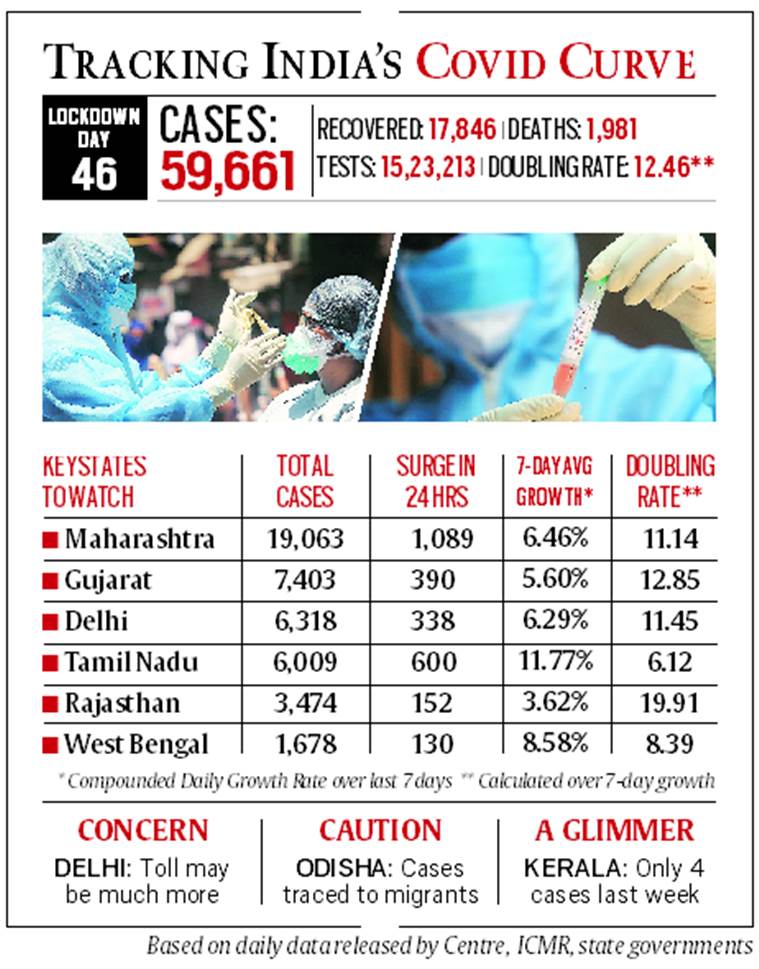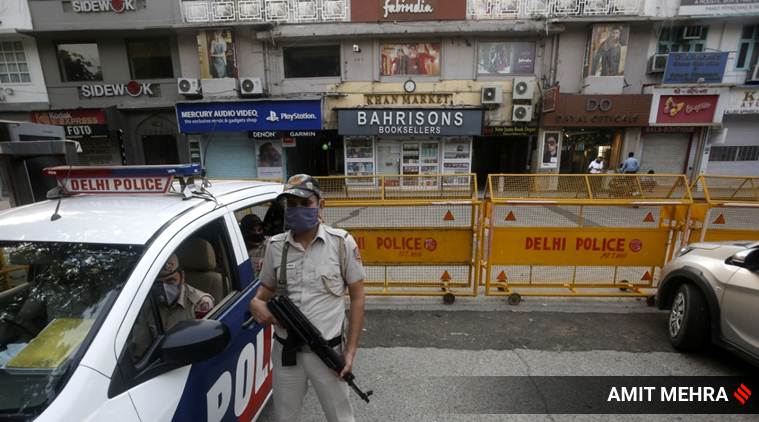 May 3 was the last day of the second phase of the lockdown.
May 3 was the last day of the second phase of the lockdown.
Though Covid-19 cases are doubling at a faster pace into the first week of the third phase of the lockdown, the general sentiment in the government appears to be against rolling back the relaxations towards a gradual un-lockdown. The nature of high-level meetings within the government and new advisories issued for Covid-19 management in the past fortnight testify to this.
As per the Health Ministry dashboard, positive cases increased from 39,980 on May 3 to 59,662 on Saturday — the number of deaths also rising within the week from 1,301 to 1,981. May 3 was the last day of the second phase of the lockdown.
On Saturday, the Health Ministry decided to deploy more Central teams to 10 states that have “witnessed/are witnessing high case load and high spurt”, including Gujarat, Tamil Nadu, Uttar Pradesh, Delhi, Rajasthan, Madhya Pradesh, Punjab, West Bengal, Andhra Pradesh and Telangana. Earlier, 20 teams of public health experts had been deployed to high-case-load districts.
At the same time, as a government source said, “Though cases are increasing, the discussions in the system are about post-lockdown activities. Different ministries are planning required action points.” Another source highlighted that the informal group of over a dozen ministers, chaired by Rajnath Singh, to guide the administration on people’s issues has virtually finished its job.
“While earlier meetings used to be about lockdown challenges and how to deal with them, the high-level meetings are now about what to do next,” said a source, referring to a series of meetings, on education, power, financial sector, agriculture, civil aviation sector among others, chaired by Prime Minister Narendra Modi.

This is also reflected in the post-meeting announcements — whether holding the remaining CBSE board exams, NEET and JEE (Main) tests, or the labour law relaxations announced by states including BJP-ruled Madhya Pradesh, Uttar Pradesh and Gujarat.
“The number of cases will keep increasing. Unless the disease takes an completely untoward turn, there is general consensus within the government to get on with the business of normal life,” confided a source.
However, issues of inter-state travel and more flexibility in red-zone districts remain undecided. The government is likely to take a call on them closer to when the third phase of the lockdown ends on May 17. A major hurdle is the fact that big urban centres such as Mumbai, Delhi, Chennai, Ahmedabad, Pune, Indore and Thane remain hotspots.
 Police on guard as few shops were opened at Delhi’s Khan Market area on Saturday. (Express photo by Amit Mehra)
Police on guard as few shops were opened at Delhi’s Khan Market area on Saturday. (Express photo by Amit Mehra)
On Saturday, the National Disaster Management Authority (NDMA) issued guidelines on “restarting manufacturing industries after lockdown” to states. While most of them deal with safety protocols regarding restarting industrial processes — coming days after the Visakhapatman factory disaster — the guidelines also cover sanitisation, health checks and quarantine-related aspects covering workers.
On the Covid-19 treatment front too, the advisories indicate creation of additional elbowroom for the long haul. On Friday, the government revised guidelines for discharge of Covid-19 patients, with mild and moderate patients no longer requiring pre-discharge tests. The government, according to sources, is also looking at better rationalisation of clinical care guidelines after data showing more people in ICU than on oxygen support.
During a review meeting on Saturday with Northeast states, Health Minister Dr Harsh Vardhan said currently 2.41% Covid-19 patients were in ICU, 0.38% on ventilators and 1.88% on oxygen support. “This has been the trend almost consistently — more patients in ICU than on oxygen — because hospitals are not leaving anything to chance. As cases rise, we need to look at this because somebody else may need that ICU bed more,” an official said.
Over the past few days, a series of steps have been taken to free up resources as projections indicate a surge in cases as the lockdown is eased:
# On Friday, May 7, the Ministry of Health said mild and moderate cases would no longer need testing prior to discharge. As per the earlier policy, patients had to test negative for discharge. “Mild/very mild/pre-symptomatic cases admitted to a COVID Care Facility will undergo regular temperature and pulse oximetry monitoring. The patient can be discharged after 10 days of symptom onset and no fever for 3 days. There will be no need for testing prior to discharge. At the time of discharge, the patient will be advised to follow home isolation for further 7 days as per guidelines.” The same applies for moderate cases, categorised as those whose symptoms resolve within three days and whose oxygen saturation in blood was above 95% for the next four days.
 The country can currently conduct 95,000 tests daily, and the government has maintained there is no dearth of kits or testing facilities.
The country can currently conduct 95,000 tests daily, and the government has maintained there is no dearth of kits or testing facilities.
“There is no need for testing at the time of discharge. It is a kit wasted. Anyway they are going to be in home isolation. The test can be done on somebody who needs it more,” a senior official said.
The country can currently conduct 95,000 tests daily, and the government has maintained there is no dearth of kits or testing facilities. So far, 15,25,631 tests have been conducted.
READ | Bhupesh Baghel writes to PM, seeks autonomy to regulate economic activities
# On April 27, the Ministry of Health amended guidelines to allow mild or asymptomatic cases to stay at home, observing strict quarantine norms, instead of a facility-based quarantine. The earlier guidelines assigned patients clinically assigned as very mild/mild, moderate or severe to Covid Care Centres, Dedicated Covid Health Centres or Dedicated Covid Hospitals accordingly. Those in home quarantine, however, have to download the Aarogya Setu app.
# On May 6, guidelines were issued regarding the use of railway coaches for cases who need minimal medical attention, to be kept ready at 215 stations across the country. A proposal from the NITI Aayog to convert at least some of the 5,000-odd coaches into full-fledged hospitals with oxygen, ICU facilities and ventilators, to be wheeled into Tier II, III cities and villages where healthcare infrastructure was limited, remains pending.
# A day later, the Health Ministry issued an SOP for hotel quarantine of those willing to pay for it, especially Indians being evacuated from abroad who are required to complete a 14-day quarantine. “This is likely to reduce the pressure on the family, give comfort to the person, and protect the family members and immediate neighborhood,” the ministry said. Sources said the ministry was not keen but the Cabinet Secretary pushed it following a recommendation from the Empowered Group on hospitals, isolation beds etc.